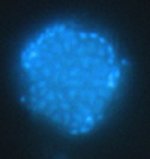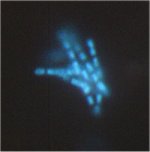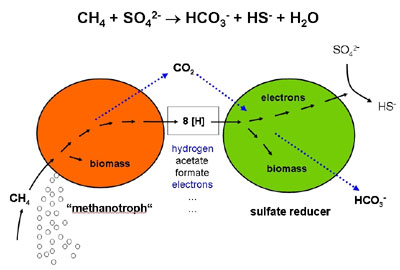 The anarobic oxidation of methane plays a major role in the sub-seafloor methane flux. However, the microorganisms responsible for this process have evaded all attempts of identification and physiological study for decades. Only quite recently has it been realized that the process is catalyzed by a consortium of prokaryotic organisms1. By combining several approaches based on 16S rDNA sequence information, isotopic composition of specific biomarkers, and radiotracer experiments it has finally been possible to make significant progress. The elusive microorganisms are, however, still not in culture. The current evidence, which is derived mostly from sediments around gas hydrates and from cold seeps on the sea floor, may be summarized as follows:
The anarobic oxidation of methane plays a major role in the sub-seafloor methane flux. However, the microorganisms responsible for this process have evaded all attempts of identification and physiological study for decades. Only quite recently has it been realized that the process is catalyzed by a consortium of prokaryotic organisms1. By combining several approaches based on 16S rDNA sequence information, isotopic composition of specific biomarkers, and radiotracer experiments it has finally been possible to make significant progress. The elusive microorganisms are, however, still not in culture. The current evidence, which is derived mostly from sediments around gas hydrates and from cold seeps on the sea floor, may be summarized as follows: ![]()

![]()
 | Possible metabolic interactions in a putative anearobically methane-oxidizing consortium consisting of a methane-oxidizing archaeon and a sulfate reducing bacterium 3 (scheme after K. Nauhaus, MPI-Bremen). |
On this background, we now have appropriate tools to unravel the function of methane oxidizing microorganisms in the sea floor and to design conclusive experiments to determine the environmental controls on their metabolism. It is an important concept for this project that the oxidation of methane in the sea floor may be a direct reversal of the methane-producing metabolism in certain archaea, whereby the direction of the process is regulated by chemical and physical parameters affecting the energy available to the microorganisms involved.
In the absence of sulfate, the pathway converting CO2 to methane is favorable, in the presence of sulfate the reverse oxidation of methane to CO2 is favorable. Hence, a thorough inventory of the relevant porewater chemistry and adequate experimental analyses may provide insight into the triggering of methane oxidation versus production. The energy yield by the reversed process is, however, at the lower limit of what is required for cells to make a living4. Accordingly, the methane oxidizing consortia may turn over large amounts of methane, with little energy left to support growth and biomass production. This energy limitation may explain why the methane oxidation remains a very sluggish process in the sea floor.
If AOM is indeed constrained by the energy yield, it should be regulated by the following parameters: temperature, pH, and concentrations of sulfate, hydrogen sulfide, bicarbonate, methane, and possibly hydrogen, acetate and/or formate. These are all key parameters, which will be analyzed in sea floor samples under WP2 and which will be varied experimentally under WP4. The results will show, whether the anaerobic oxidation of methane takes place under constant, minimum energy yield and whether the process rate is thus under energy control.
Literature:
2) Hinrichs, K.-U., J.M. Hayes, S.P. Sylva, P.G. Brewer and E.F. DeLong (1999) Methane consuming archaebacteria in marine sediments. Nature. 398:802-805.
4) Schink, B. (1997) Energetics of syntrophic cooperation in methanogenic degradation. Microbiol. Mol. Biol. Rev. 61: 262-299.
back to top